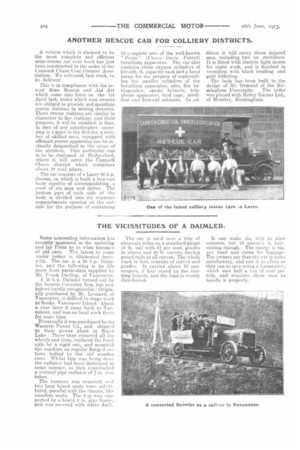THE VICISSITUDES OF A DAIMLER.
Page 30

If you've noticed an error in this article please click here to report it so we can fix it.
Some interesting information has recently appeared in the motoring and lay Press as to what becomes of old oars. The latest to come under notice is illustrated herewith. The car is a 35 h.p. Daimler, and the following is its life story from particulars supplied Ity Mr. Frank Darling, of Vancouver.
A 33 h.p. Daimler turned out by the famous Coventry firm, but now indeed hardly recognizable ! Originally purchased by Mr. Leonard, of Vancouver, it drifted to stage work at Sooke, Vancouver Island. About a year later it came back to Vancouver, and was on local work there for some time.
Eventually it was purchased by the Western Power Co., and shipped to their power plant at Stave Lake. There they removed all the wheels and tires, replaced the front axle by a rigid one' and mounted the machine on regular flanged car tires bolted to the old wooden ones. Whilst this was being done the radiator had been destroyed in some manner, so they constructed a vertical pipe radiator of in. iron tubes.
The tonneau was removed, and two long board seats were suh3tituted, parallel with the ehassis, like omnibus seats, The tep was supported by a heavy 1 in. pipe frame, and was covered with white duck. The car is used over a trip of about six miles on a standard gauge 40 lb. rail with 6.4 per cent. grades in places and 20 ft. curves, having guard rails at all curves, The whole road, in fact, consists of curves and grades. It carries about 13 passengers, if four stand on the running boards, and the load is evenly distributed.
It can make the trip in nine minutes, but 12 minutes is hairraising enough. The charge is '25c. per head and extra for luggage. The owners say that the car is quite satisfactory, and run it as often as they can to save using a locomotive, which uses half a ten of coal per trip, and requires three men to handle it properly.
































